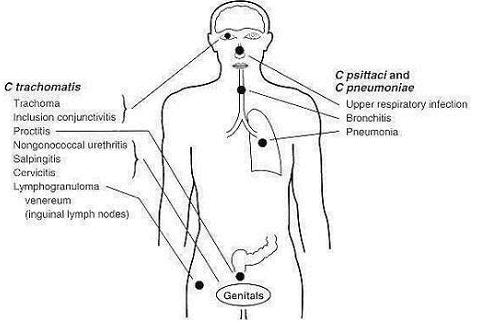Chlamydia trachomatis*
A Microbial Biorealm page on the genus Chlamydia trachomatis*
Classification
Higher order taxa
Bacteria; Chlamydiae/Verrucomicrobia group; Chlamydiae; Chlamydiae (class); Chlamydiales; Chlamydiaceae; Chlamydia
Species
C. trachomatis
Description and significance
Chlamydia trachomatis is a bacterium that causes ocular and genital tract infections in humans. C. trachomatis is the world’s leading cause of preventable blindness. This condition, known as trachoma, currently infects some 150 million people in the world (Chlamydia). C. trachomatis is the most common cause of sexually transmitted bacterial disease in the United States. Each year approximately 4 million new cases are reported in the United States and 50 million worldwide (pathmicro).
In ocular infections, C. trachomatis can be passed from person to person through direct contact in the eye with infected ocular or nasal fluids, sneezing or coughing, sharing clothing or towels, and eye-seeking flies (medicalecology). Initial infections result in swollen eyelids, sensitivity to light, and discharge from the eye. Recurrent infections, when left untreated, will produce scarring, and eventually lead to blindness. Instances of trachoma throughout history have been reported in Ancient Egypt, Ancient Greece, and trachoma was a health concern in the United States and Europe during the 19th and 20th centuries (medicalecology). In genital tract infections, C. trachomatis is transmitted through unprotected sexual contact with an infected person. Symptoms will develop within 1 and 3 weeks after infection and include abnormal discharge from the gentials, and painful urination. Most people with an infection will not exhibit symptoms, and left untreated, it can lead to pelvic inflammatory disease in women and epididymitis in men (antigenics).
Because the majority of people with chlamydial infections will not show symptoms, they can unknowingly spread the bacteria to others. Distancing yourself from people with active eye infections, abstaining from sexual contact, and using latex condoms correctly and consistently can significantly reduce your chances of spreading or contracting the bacteria. Additionally, doctors recommend regular tests for people under 25, especially if you have more than one sexual partner, even if you have no symptoms (antigenics).
Genome structure
The entire genome sequence for C. trachomatis became available in 1998. It consists of a 1,042,519-bp chromosome and a 7,493-bp plasmid. This plasmid is a believed to be contributor to the the organism's ability to cause disease, but it's encoding gene products and their function is still unknown. Chlamydiae have a relatively small genome when compared to other bacteria. It's genome is only slightly larger than Mycoplasma, which possesses the smallest genome, and about one-fourth of the size of Bacillus subtilis or Escherichia coli.
C. trachomatis exists as an elementary body and reticulate body. The elementary body, which is an infectious, nonreplicating particle, has a rigid cell wall, a genome of around 600 genes, and a plasmid with 7,498 base pairs. The elementary body also has an open reading frame for a gene responsible for DNA replication, and has an RNA polymerase responsible for transcripting the DNA genome after invading a host cell. The reticulate body actually grows and replicates, and houses the DNA genome, proteins, and ribosomes during the developmental cycle. C. trachomatis has 894 protein coding sequences that are between 135 – 5,358 nucleotides long. There are over 15 serovariants, four of which are associated ocular infection (serovariants A, B, Ba, and C). There is very little different between the gene structure of C. trachomatis and the other forms of Chlamydia, infact, C. trachomatis is 99.6% similar in gene structure to the other types of Chlamydia. The difference between C. trachomatis and other Chlamydial bacterias is an altered gene in the trp-pathway
Cell structure, metabolism & life cycle
C. trachomatis is aerobic and intracellular. Most often you will find that the bacteria is coccoid or rod shaped. C. trachomatis requires growing cells to remain viable. Because C. trachomatis cannot produce its own ATP, it cannot be produced artificially, making people once believe it was a virus. The cell wall inhibits phagolysosome fusion in thephagocytes. It also contains an outer lipopolysaccharide membrane that contains cysteinepeptidogly can allowing for intracellular division as well as cell survival.
C. trachomatis has a glycolytic pathway which is liked to tricarboxylic acid cycle. C. trachomatis uses a form of electron transport to produce energy. Glycogen synthesis and the use of glucose derivatives influence the chlamydial metabolism.
C. trachomatis goes through two stages during its life. First, in the elementary stage C. trachomatis is a spore and it induces its own endocytosis when exposed to potential host cells. By having the elementary stage the bacteria avoids phagolysomomal fusion and has a better chance of intracellular survival. When the bacteria is inside the endosome, the glycogen that is produced causes germination. C. trachomatis has an incubation period of 7-21 days. The bacteria becomes a part of the cell. The second stage comes after the division of the cell, the reticulate body changes back into the elementary form and the cycle continues.
Ecology (including pathogenesis)
C. trachomatis is a small bacterium that cannot grow outside a living cell. C. trachomatis is a parasite to eukaryotic cells and cannot develop without a host cell, due to the lack of ATP produced by the bacterium alone. C. trachomatis can be spread in many different ways. The sexually transmitted disease can be spread during oral, vaginal or anal sexual contact with an infected partner. Also babies born to mothers with C. trachomatis can develop the infection in their eyes or in their respiratory systems leading to pneumonia from the birth canal. Also, in third world countries, flies that land of the faces of infected children can spread the infection as flies are vectors for the bacteria. Furthermore, the infection can be spread by clothing and hand contact. The infection is widespread in the Middle East, Africa, southern Asia, and China. There are approximately 90 million new infections each year. While most of the time C. trachomatis is asymptomatic in the hosts, it can cause, blindness (from eye infections), pink eye, abnormal discharge such as mucus or pus, from the vagina or penis, or pain during urination. If not treated, the infection can move inside the body and cause rectum inflammation, pelvic inflammatory disease in women, and inflammation of the testis in men.
Interesting feature
Describe in detail one particularly interesting aspect of your organism or it's affect on humans or the environment.
References
Raulston, Jane E., and Priscilla B. Wyrick.“Chlamydia.” Encyclopedia of Microbiology. 2nd edition. 2000.
Mayer, Eugene. "Chlamydia." 2003. http://pathmicro.med.sc.edu/2003-bacpdf/Chlamydia2003.pdf
Tan, Timothy. "Trachoma." 2004. http://www.medicalecology.org/water/trachoma/trachoma.htm#sect2
Antigenics Inc. 2007. http://www.antigenics.com/diseases/chlamydia.html
[Stephens, Richard S. Chlamydia. University of California, Berkeley. 1999]
Shen, Caixa. "Chlamydia Lab." 2004. http://www.cdc.ubc.ca/Research/ChlamydiaLab.htm
Bischoff, Joe. et al. "Chlamydia trachomatis." 2007. http://www.ncbi.nlm.nih.gov/Taxonomy
Edited by the NC State University MB 103 class of 2007.


